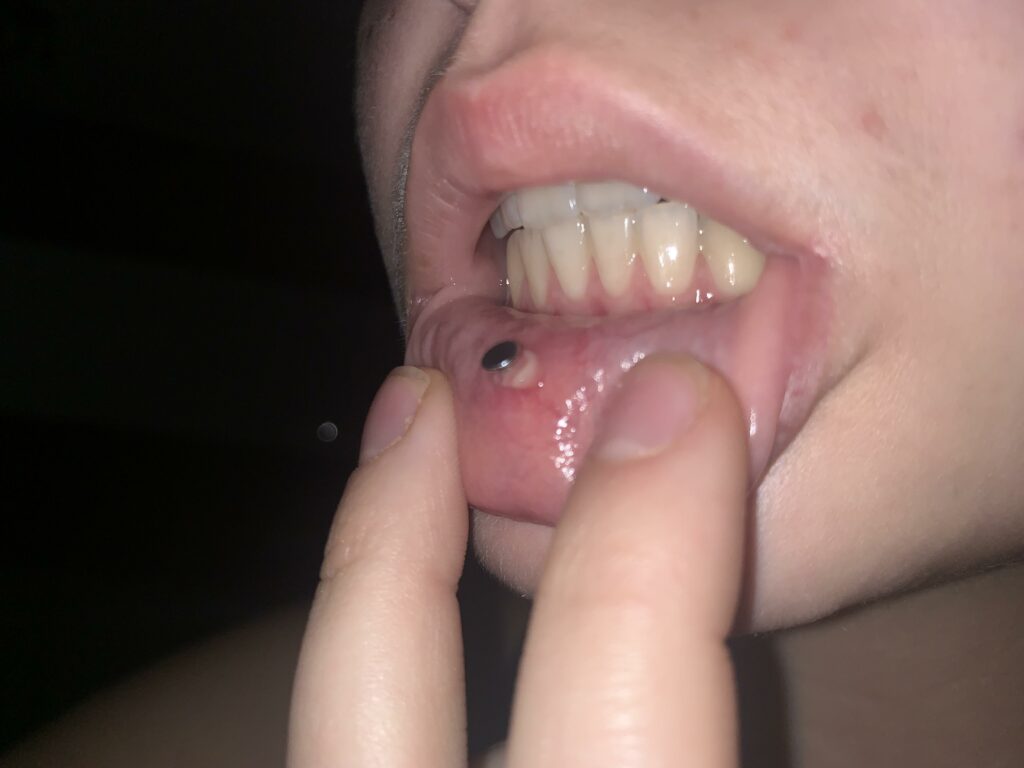If you’re enthusiastic about lip piercings, including the possibility of an infected lip piercing, that’s okay by us.
We firmly believe in everyone’s right to express themselves. Nonetheless, when it comes to lip and oral piercings, there are certain aspects you should consider before getting one.
How to Treat an Infected Lip Piercing at Home?
Have you recently gotten a lip piercing? If you have, it’s important to be aware of the potential signs of an infected lip piercing, such as swelling.
This guide will provide information on how to address an infected lip piercing and when it might be necessary to consult a doctor. Additionally, we’ll discuss proper aftercare for your lip piercing and strategies to prevent infections.
How Do I Know If My Lip Piercing Is Infected?
Getting a lip piercing is notably more sensitive than having your earlobe pierced. This is because the piercing is done through the mouth, an area rich in bacteria and consistently warm and humid.
An infection resulting from a lip piercing can present itself in various ways, encompassing minor and more prominent signs of infection.
Minor Inflammation or Swelling and Localized Swelling
One sign to watch for is a bit of swelling or redness around the piercing. Getting a piercing is like having a small open cut. Some people also feel a pulsing sensation they can’t control, and that’s normal.
Sometimes, you might notice a bump near the front or inside of the lip piercing. If you see a bump, it’s best to ask a doctor about it. Bumps aren’t usual and could mean a serious infection or something worse.
Also, the pierced area might feel warmer than usual. This is because your body’s defence system is fighting an infection. More blood flows to the area, making it warmer – that’s what doctors call “persistent warmth.”
Discharging from the Wound
Another thing to watch out for is any liquid coming from the wound. This liquid might be clear, or sometimes it could look yellowish or creamy.
If an infection worsens, it can harm the area, and this kind of liquid might show up. Sometimes, when parts of your skin are hurt, they release liquids. While this doesn’t always mean something bad, it could mean an infection starts.
If you see a lot of bleeding, that’s not good. Don’t touch the piercing or try anything with it – just get help from a doctor as soon as possible.
The same goes if you notice a greenish colour or suddenly get a fever a few days after getting the piercing.
These are serious signs that you should talk to a doctor about. If you see any of these last symptoms, it’s important to see a doctor quickly. Don’t wait until tomorrow; go see them today.
How to Heal an Infected Lip Piercing?

Cleaning with Saline Solution
Caring for a lip piercing is quite straightforward. One effective method involves using saline solution, which is cost-effective and suitable for various piercing types.
To achieve the best results, utilize a clean cloth to dip into the saline solution. However, avoiding using materials like paper towels that might disintegrate when wet is important.
Gently pat the area around the piercing using a damp cloth. Take your time and handle it gently. If you come across any minor crusts around the piercing, continue patting until they disappear.
It’s perfectly fine if a small amount of saline solution enters the wound – it’s harmless. Repeat this process whenever necessary until the wound and the surrounding skin appear clean.
It’s crucial to note that there’s no need to scrub the piercing or the adjacent area vigorously.
Such scrubbing could lead to issues like irritation or harm to the tissue. Accidental tissue damage might worsen pain and impede the healing process, which you certainly want to avoid.
Cleaning with Salt and water
If you’re not interested in purchasing a saline solution, you have the option to make your own. Just mix eight tablespoons of regular Salt with a glass of water.
If available, distilled water or at least purified water is recommended. The cleaning process remains consistent.
Use of Alcohol-free Mouthwash
When saline solution isn’t an option, you can try using alcohol-free mouthwash temporarily. However, it’s important to note that this isn’t a substitute for saline solution, which is the recommended method for cleaning different types of wounds.
How to Prevent a Lip Piercing Infection?
Do Not Touch Labret/Lip Piercing
To start, avoid touching your labret piercing or any other lip piercing you might have. Our hands aren’t always perfectly clean, and even if they appear to be, bacteria (or even viruses) can likely land on our fingertips.
Given that piercings act as open wounds, there’s a potential for infection if you handle the piercing. We also suggest refraining from moving the jewellery post around or taking it out.
Do Not Remove Lip Jewelry From Un-healed Piercing
We recommend avoiding removing the post until the wound is fully healed. If you believe it’s necessary to remove it, it’s best to consult a doctor or get in touch with the professional piercer who performed the piercing originally.
Trying to remove the post from a fresh piercing at home isn’t advisable, as you might lack the proper equipment and knowledge.
Moreover, attempting this could lead to further tissue damage around the piercing. If you’re unable to contact the piercer, your best course of action is to see a general practitioner or visit an emergency room.
Wash Your Piercing Daily
Another method to ensure the well-being of your lip piercing is to be diligent about cleaning it daily. While we understand that the mouth contains bacteria, it’s important to remember that this is a wound that requires regular cleaning.
For freshly pierced lips, gently wash the area using a saline solution or a cleansing product recommended by your professional piercer.
When is it Time to See a Doctor for Lip Piercing Infection?
As we discussed, it’s important to pay attention to worrisome signs such as discharges, continuous bleeding, and severe pain in the lip area.
Prolonged bleeding is especially concerning because lip piercings shouldn’t bleed excessively. While a little bleeding might occur right after piercing, it should decrease over time as the body’s natural clotting mechanism comes into play.
If you observe the presence of pus, it’s a cause for alarm because the lip area has limited space. When both pus and bleeding are present, tissue damage can occur rapidly.
How to Know if My Lip Piercing Is Healed?
You’ll be able to see that your lip piercing is healing well when there’s no more pain, discharge, or any signs of infection. Once you reach this point, you can start thinking about changing your lip jewelry to try out different styles.
However, avoiding changing the lip post is important until the piercing has fully healed.
How To Care For Your Oral Piercing
To ensure you don’t face infection, tooth problems, or gum complications, adhere to these guidelines for proper care of your oral piercing:
Regularly clean and disinfect the area around your oral piercing thoroughly to prevent the buildup of bacteria and potential infections.
After eating, it’s important to rinse with water to eliminate any food particles that might attract bacteria.
Avoid tampering with your oral piercing to minimize the risk of harming your teeth and gums.
If you’ve already had a portion of your mouth pierced, stay alert for indications of infection, such as swelling, redness, fever, chills, or trembling. If you notice any of these signs, seek medical assistance promptly.
More Body Piercings
Double Nose Piercing: A Complete Guide
Nose Piercing 101: Everything You Need to Know
Getting Your Ears Pierced at Target (Through Rowan)
Ashley Piercing: Everything You Need to Know About Eye-Catching Lip Piercing
Ashley Piercing Scar: Every Thing you Need to know About Ashley Piercing Scarring
The Labret Piercing: Everything You Need To Know
Everything You Need to Know About Vertical Labret Piercing
Do You Want a Bottom Lip Piercing?: A Complete Guide
What Is Snake Bites Piercing: How to Care For It
Horizontal Lip Piercing – Ultimate Experience Guide
The Medusa (Philtrum) Piercing: Everything You Need To Know
Conclusion
In conclusion, while lip piercings allow self-expression, it’s important to understand their care. Watch for signs of infection, follow proper healing steps, and avoid touching or removing jewellery prematurely.
Seek medical help for alarming symptoms. Once healed, you can experiment with jewellery. For oral piercings, clean regularly, rinse after eating, and refrain from playing with the piercing.
Stay vigilant for signs of trouble and seek prompt medical attention if needed.
FAQs
Question: How should you handle an infected lip piercing?
Answer: For minor local infections, you can use conservative treatments like warm compresses and over-the-counter or prescription topical antibiotics such as bacitracin or mupirocin.
Oral antibiotics like cephalexin or clindamycin can also help with infections caused by streptococcus and staphylococcus bacteria.
Question: What are the signs of an infected lip piercing?
Answer: An infected lip piercing might show symptoms like increasing pain, excessive bleeding, the presence of pus, or a bump in front of or behind the piercing.
Question: How can you recognize a severe infection in a piercing?
Answer: An infected ear piercing could appear red, swollen, sore, warm, itchy, or tender. Sometimes, the piercing might release blood, white, yellow, or green pus. Remember, a new piercing is an open wound that takes a few weeks to heal fully.
Question: Is it possible to salvage a piercing that’s infected?
Answer: If the infection is minor, you can manage it at home. However, it’s best to seek medical attention if you have a cartilage piercing that seems infected.
Cartilage infections are trickier to treat and might need oral antibiotics. In severe cases, hospitalization might be necessary for significant cartilage infections.
Question: How can I personally treat an infected piercing?
Answer: Gently dry the affected area using clean gauze or tissue.
Afterwards, apply a small amount of over-the-counter antibiotic cream (like Neosporin or bacitracin), following the directions on the product label. To prevent the jewellery from sticking to the skin, turn it a few times.




